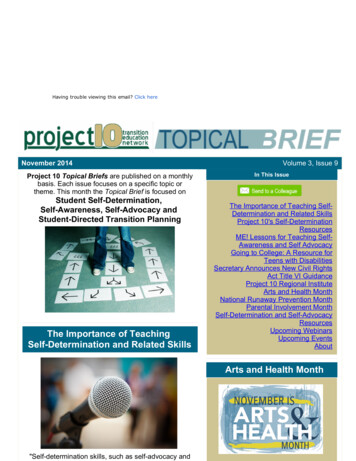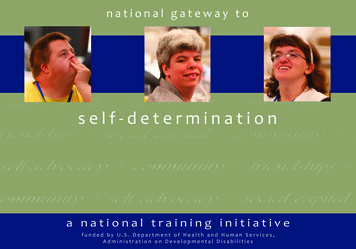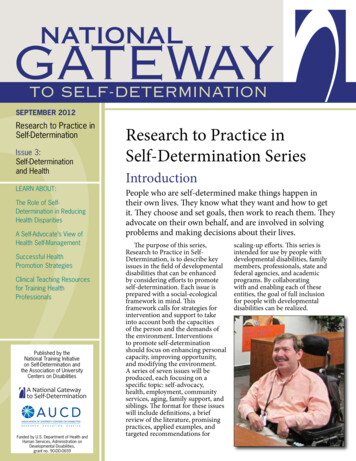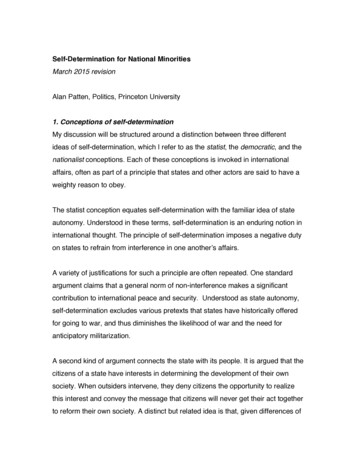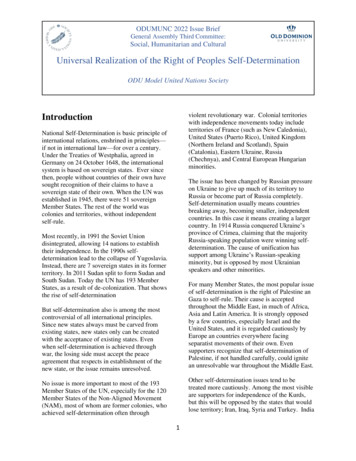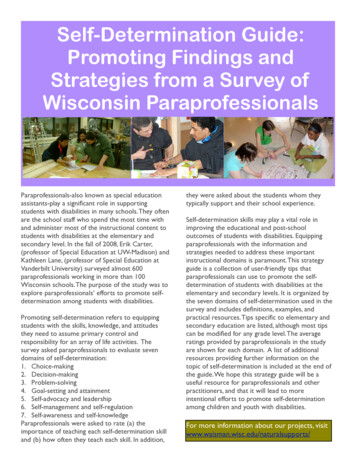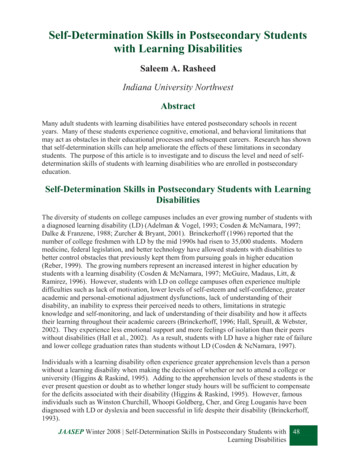
Transcription
Self-Determination Skills in Postsecondary Studentswith Learning DisabilitiesSaleem A. RasheedIndiana University NorthwestAbstractMany adult students with learning disabilities have entered postsecondary schools in recentyears. Many of these students experience cognitive, emotional, and behavioral limitations thatmay act as obstacles in their educational processes and subsequent careers. Research has shownthat self-determination skills can help ameliorate the effects of these limitations in secondarystudents. The purpose of this article is to investigate and to discuss the level and need of selfdetermination skills of students with learning disabilities who are enrolled in postsecondaryeducation.Self-Determination Skills in Postsecondary Students with LearningDisabilitiesThe diversity of students on college campuses includes an ever growing number of students witha diagnosed learning disability (LD) (Adelman & Vogel, 1993; Cosden & McNamara, 1997;Dalke & Franzene, 1988; Zurcher & Bryant, 2001). Brinckerhoff (1996) reported that thenumber of college freshmen with LD by the mid 1990s had risen to 35,000 students. Modernmedicine, federal legislation, and better technology have allowed students with disabilities tobetter control obstacles that previously kept them from pursuing goals in higher education(Reber, 1999). The growing numbers represent an increased interest in higher education bystudents with a learning disability (Cosden & McNamara, 1997; McGuire, Madaus, Litt, &Ramirez, 1996). However, students with LD on college campuses often experience multipledifficulties such as lack of motivation, lower levels of self-esteem and self-confidence, greateracademic and personal-emotional adjustment dysfunctions, lack of understanding of theirdisability, an inability to express their perceived needs to others, limitations in strategicknowledge and self-monitoring, and lack of understanding of their disability and how it affectstheir learning throughout their academic careers (Brinckerhoff, 1996; Hall, Spruill, & Webster,2002). They experience less emotional support and more feelings of isolation than their peerswithout disabilities (Hall et al., 2002). As a result, students with LD have a higher rate of failureand lower college graduation rates than students without LD (Cosden & NcNamara, 1997).Individuals with a learning disability often experience greater apprehension levels than a personwithout a learning disability when making the decision of whether or not to attend a college oruniversity (Higgins & Raskind, 1995). Adding to the apprehension levels of these students is theever present question or doubt as to whether longer study hours will be sufficient to compensatefor the deficits associated with their disability (Higgins & Raskind, 1995). However, famousindividuals such as Winston Churchill, Whoopi Goldberg, Cher, and Greg Louganis have beendiagnosed with LD or dyslexia and been successful in life despite their disability (Brinckerhoff,1993).JAASEP Winter 2008 Self-Determination Skills in Postsecondary Students with 48Learning Disabilities
Research has shown that transition issues faced by students with LD include initiating ormaintaining employment, pursuing postsecondary education, adjusting to social and communitylife, and being able to live independently (Hoy, Gregg, Wisenbaker, Manglitz, King, &Moreland, 1997). Although students with LD realize that they have problems, they do notunderstand how their deficits affect their performance in school (Adelman & Vogel, 1993). As aresult, they are often unable to develop compensatory strategies to help them meet theresponsibilities of timely completion of duties or assignments (Adelman & Vogel, 1993). Manyof them do not understand their disability, how it affects their learning, or how to describe it toothers in plain language (Brinckerhoff, 1996). Many college-age students with LD are deficientin the content preparation necessary to succeed in college (Brinckerhoff, 1996). According toMcGuire, Norlander, and Shaw (1990), students with LD suffer from this under-preparednessbecause of a system of “tracking” established in high school.Tracking allows limited choice in course selection in high schools; therefore, some students withLD do not meet post-secondary requirements for admission even though they have all of theaptitude for college studies. Curriculum decisions which are made early in the student’s highschool program may inadvertently be limiting any post-secondary options for students with LD(McGuire et al., 1990). Difficulty in matching the student’s academic preparedness with acollege’s expectations may result in students with LD being unable to compete with their peersand later dismissed from the school due to this mismatch (Dalke & Franzene, 1988). Afterleaving high school, one of the reasons why students with disabilities are not more successful isbecause the educational process has not prepared them to be self-determined young adults(Wehmeyer & Schalock, 2001). Brinckerhoff (1996) reports that, even though students with LDhave been admitted to college, they very often need services that help them stay there in order tograduate.Current research findings, regarding employment of adults with learning disabilities indicate thatmost of these individuals work on a part time basis or at an entry level position for minimumwages (Sittlington, Frank, & Carson, 1993; Williams, 1998). Rojewski (1996) emphasized thatpersons with learning disabilities are more likely to be underemployed and concentrated inlower-prestige occupations which deemphasize academic skills while capitalizing on individualstrengths. Research has also shown that, despite average or above average intelligence, fewerstudents with learning disabilities choose to attend either a two or a four-year college than theirpeers without disabilities (Williams, 1998). Only 23% of students with learning disabilitiesversus 56% of students without disabilities enroll in postsecondary education (Adelman &Vogel, 1993).Recent research has shown that self-determined students with cognitive or learning disabilitiesare more likely to be employed and have higher earnings than their peers with similar disabilitieswho are not as self-determined (Field & Hoffman, 2002). Self-determination curricula has had adefinite, positive impact on high school students with mild cognitive disabilities, students withmoderate to severe mental retardation, and students with cross-categorical special needs (Nevin,Malian, & Williams, 2002). Wehmeyer and Schwartz (1997) used The Arc’s Self-DeterminationScale as a questionnaire for 80 high school students with cognitive disabilities (mentalretardation and learning disabilities) to assess adult outcomes one year after their graduation.The sample was divided into dichotomous groups based on a frequency distribution of selfdetermination total scores with the top and bottom third of each frequency count (MR and LD)assigned to a high or low self-determination groups. This ensured that groups consisted ofstudents with different levels of self-determination.JAASEP Winter 2008 Self-Determination Skills in Postsecondary Students with 49Learning Disabilities
They found that:Throughout the data there was a consistent trend characterized byself-determined youth doing better than their peers 1 year out of school.Members of the high self-determination group were more likely to haveexpressed a preference to live outside of the family home, have a savingsor checking account, and be employed for pay. Students who earned themost had significantly higher self-determination scores . (Wehmeyer &Schwartz, 1997, p. 253)Many studies on learning disabilities have been conducted in elementary and secondary schools(Coffey & Obringer, 2000; Field, Sarver, & Shaw, 2003; MacMillan, Gresham, Bocian, &Siperstein, 1997; Shepard, Smith, & Vojir, 1983; Vaughn, McIntosh, Schumm, Haager, &Callwood, 1993). However, “Unlike their counterparts in elementary and secondary schools,postsecondary students with learning disabilities represent a relatively unstudied subpopulationof students with disabilities” (Zawaiza & Gerber, 1993, p. 65). All things considered, very littleresearch on self-determination skill levels or its correlates has been conducted on the populationof students with LD at the postsecondary level (Zawaiza & Gerber, 1993). There is little dataavailable on the attendance and/or completion rates in vocational programs or graduation fromcollege rates for students who have learning disabilities (Adelman & Vogel, 1993). It has beendifficult to assess current adult outcomes for people with disabilities because very fewresearchers cared to ask and definitional inadequacies have limited the validity of the findingsfrom those investigations which did focus on that question (Wehmeyer, 1997).The purpose of this article is to investigate and to discuss the level and need of selfdetermination skills of students with learning disabilities who were enrolled in postsecondaryeducation. Information is provided on attitudes towards disability, the definition of a learningdisability, and the prevalence and incidence rates of students with LD. Next, the problemsstudents with LD may face in their educational or vocational lives, some specific demographicvariables addressed in LD research, and the effects of the disability on students in college arediscussed. Motivational and attribution factors, as well as locus of control and self-efficacy ofstudents with LD, are also addressed in this commentary. Lastly, aspects of self-determinationare discussed such as: its roots, effects of legislation, definition and component parts, and theteaching of self-determination in the school system.Attitudes Toward DisabilitiesSocietal attitudes towards individuals with disabilities have changed over the centuries. Similarto the roles of women and members of minority ethnic groups, individuals with disabilities havebeen distinctly underplayed or totally absent from academic discussion in the histories of Europeand the United States (Kent, 2001). In early Greek and Roman eras, people with physical andmental disabilities were thought to have their conditions because their souls had somehow been“cursed” by the deities or because they were sinful (Rubin & Roessler, 2001; Snow, 2001).People with disabilities were killed either for economic reasons, to promote population control,or simply because the father disapproved of the child due to its disability (Rubin & Roessler,2001). Leaders in Greece, such as Aristotle, had established an understanding of the idea of aperfect human body for that society so that anyone born with a disability was subsequentlyviewed as imperfect and considered as deformed, monstrous, deviant, or mutilated (Kudlick,2003). Additionally, early Greek and Roman laws mandated the desertion or death of babiesJAASEP Winter 2008 Self-Determination Skills in Postsecondary Students with 50Learning Disabilities
with disabilities to fulfill their societies’ quest for “human perfection” (Snow, 2001). Thisnegative societal attitude towards people with disabilities actually represented an early form ofeugenics that carried over into modern times (Rubin & Roessler, 2001; Snow, 2001).During the early part of the Christian era and the Middle Ages, people with disabilities werepresent everywhere in society, but had been excluded from the Old Testament and wereconspicuously absent in history books (Kent, 2001). It was widely thought that disabilities werea direct result of the people being sinful (Snow, 2001). Consequently, during these periods theywere treated in the monasteries by priests and monks through methods such as exorcisms ratherthan by physicians (Rubin & Roessler, 2001; Snow, 2001). Individuals with mental illnessreceived less humane treatment methods such as starvation, whipping, or immersion in hot waterin order to drive out the supposed devil causing their disability (Rubin & Roessler, 2001). Snow(2001) reported that a continuum of treatment methods were used ranging from prayer to beatingthe devil out of the person with the disability. From the sixteenth to the eighteenth century,people with mental illnesses were thought to be sick rather than possessed by the devil;consequently, they were placed in asylums that were very similar in patient treatment to that ofprisons rather than hospitals (Rubin & Roessler, 2001). Despite these prevailing negativeattitudes, there were instances of positive attitudes displayed by ancient leaders such asHippocrates. He presented Greek society with the idea that mental illness was caused by theinteraction of the human being and her/his environments rather than that of supernatural causes(Rubin & Roessler, 2001). Perhaps, Hippocrates rejected the supernatural pathology because hewas a physician himself. Consequently, sanitariums were designed that provided more humanetreatment efforts that included occupation, exercise, and entertainment (Rubin & Roessler,2001). Roman society provided equally humane treatment methods to those who were of theupper classes but the lower classes received harsher treatment methods which included starvation(Rubin & Roessler, 2001).In America’s twentieth century, the trend in attitudes towards those with disabilities became oneof preventing them from reproducing as Chief Justice Oliver Wendell Holmes proclaimed that,“Three generations of imbeciles is enough” (Snow, 2001, p.1). This attitude towards people withdisabilities amounted to a modern day form of eugenics (Snow, 2001). In America, suchattitudes resulted in hundreds of thousands of men, women, and children with disabilities beingabandoned in institutions, where segregation, isolation, various forms of abuse, and death werequite common occurrences (Snow, 2001). Still, government officials and political leaders of theearly twentieth century began to realize a need for vocational rehabilitation programs due tochanges in society prompted by the Industrial Revolution and wars. Large numbers of industrialworkers were injured while on the job and these occurrences resulted in early workers’compensation laws (Rubin & Roessler, 2001). Soldiers wounded in war could benefit more fromvocational rehabilitation programs than they could from social isolation programs ofinstitutionalization. The Soldier’s Rehabilitation Act (1918) authorized vocational rehabilitationservices for returning veterans with disabilities resulting from their military service (Rubin &Roessler, 2001). Legislation passed during the presidencies of Eisenhower, Kennedy, andJohnson expanded funding for rehabilitation services so much that the years from 1954 to 1972became known as the Golden Era of Rehabilitation (Rubin & Roessler, 2001). This era became“ a time of increased funding for client services, expanded training opportunities forrehabilitation personnel, further development of rehabilitation facilities, and implementation ofmany significant rehabilitation research projects” (Rubin & Roessler, 2001, p. 40).JAASEP Winter 2008 Self-Determination Skills in Postsecondary Students with 51Learning Disabilities
This time period fostered a slowly changing attitude towards persons with disabilities as furtherlegislative assistance from the federal government reflected the changing attitudes of people asbeing more amenable towards those with disabilities who needed rehabilitation. The subsequentpassage of policies, such as Section 504 of the Rehabilitation Act of 1973, the Americans withDisabilities Act (ADA) of 1990, and the Individuals with Disabilities Education Act (IDEA) of1997 were instrumental in ensuring equal access to education for people with disabilities andsimultaneously improving the attitudes and treatment of this population by individuals in society(Rao, 2004). IDEA has been amended on several occasions, most recently in 2004 as P. L. 108 –446, and is now known as the “Individuals with Disabilities Education Improvement Act, 2004.”Research indicated that employees with disabilities were equal to people without disabilities interms of their productivity, turnover rates, absenteeism, and accident rates (Berry & Meyer,1995). “In some cases, employees with disabilities have been shown to be more productive[italics added], have better work attitudes, and lower absenteeism, turnover and accident ratesthan non-disabled employees” (Berry & Meyer, 1995, p. 212). Despite these positive findings,concerns of skepticism still existed among employers with regard to the cost of reasonableaccommodations, providing interpreters, adjusting examinations and training materials, adaptingwork schedules and other employer’ apprehensions (Berry & Meyer, 1995). It became apparentthat attitudinal barriers towards people with disabilities were quite commonplace in societydespite the good intentions of policymakers and the presence of legislation designed to eradicatesaid barriers.Regrettably, it was the negative, non-accepting attitude towards people with disabilities thatresulted in society’s wariness, even to the point of hostility, regarding the idea of communityintegration that permeated society (Yazbeck, Villy, & Parmenter, 2004). Negative attitudestoward disability have seriously obstructed the progress of people with disabilities inclusion inschools, the workplace, the broader community, and unjustifiably confined the choices oralternatives created by professionals for people with disabilities receiving services (Gilmore,Campbell, & Cuskelly, 2003). In fact, professionals’ negative attitudes towards disability, andthose that have disabilities, affected the delivery of the quality of services as well as theoutcomes of those services (Wong, Chan, Cardoso, Lam, & Miller, 2004). Berry and Meyer(1995) reported that people without disabilities may have low expectations of people withdisabilities; consequently, they were expected not to behave in a competent manner in theworkplace, school, or community. People without disabilities have displayed behaviors such asdevaluating pity, avoidance, and exclusion when they encountered people with disabilities (Berry& Meyer, 1995). In the end, these negative attitudes towards people with disabilities affectedtheir successful rehabilitation, education, integration, and their ability to live independently(Wong et al., 2004).Just as adults needed laws in the workplace, adolescents and children with disabilities needspecial laws in schools (i.e., IDEA, 2004) to be afforded the special protections necessary forcombating negative attitudes towards people with disabilities (McGrath, Johns, & Mathur,2004). York and Tundidor (1995) conducted 12 interviews with 257 secondary-age studentswithout disabilities to investigate their attitudes about inclusive education as experienced bytypical high school students, to understand their recommendations about inclusive education, andto give voice to their concerns about this educational practice. The researchers noted that threemain barriers to inclusion were identified by the students: 1) the teasing of students withdisabilities, 2) the challenging behaviors of students with disabilities, and 3) the negative adultattitudes towards students with disabilities (York & Tundidor, 1995). Bunch and Valeo (2004)stated that students with disabilities generally have “lower positions of status” than their nonJAASEP Winter 2008 Self-Determination Skills in Postsecondary Students with 52Learning Disabilities
disabled peers and that this attitude of rejection displayed by peers without disabilities is basedupon their observation that students with disabilities do not exhibit acceptable behavior in bothgeneral and special education classes. Whenever a teacher responded to a student with disability,in a manner marking her or him as different from students without disabilities, the studentswithout disabilities also viewed the student as different (Bunch & Valeo, 2004). This has led toabusive behavior, a lack of friendships, and the need to protect students with disabilities (Bunch& Valeo, 2004). Children with intellectual disabilities, such as learning disabilities, oftenexperience social isolation, social neglect, rejection by their peers, and their social skills may beassessed as low by their teachers (Nowicki & Sandieson, 2002).Gender and age are two personal factors found in previous research to be correlated withchildren’s and youth’s attitudes toward their peers with disabilities (MacMillan, Widaman,Balow, Hemsley, & Little, 1992; McDougall, DeWit, King, Miller, & Killip, 2004). Males holdmore negative attitudes toward their peers with disabilities than do females (McDougall et al.,2004; Nowicki & Sandieson, 2002; Rao, 2004; Yazbeck et al., 2004). McDougall et al. (2004)claimed that attitudes become more negative in early adolescence than in the higher grades.However, other researchers found that attitudes giving rise to discrimination against people withdisabilities have been noted as less prevalent among younger than older people (Yazbeck et al.,2004). The latter finding was explained by the fact that older people grew up in an era in whichpeople with disabilities were placed in residential hospitals and were less visible to thecommunity; therefore, they might not be as influenced by “political correctness” or feel obligedto provide “acceptable” responses as would younger people (Yazbeck et al., 2004).Perhaps, these contradictions can best be explained by Yazbeck et al. (2004) who asserted thatthe inconsistency in the findings could be due to the type of contact people have with those withdisabilities. In order to promote positive attitudes towards people with disabilities, it is notsufficient to only promote contact with people with disabilities to overcome negative attitudes.The type of contact with people who have disabilities should be structured, organized along ameaningful dimension, and the quality of the contact must be high (Yazbeck et al., 2004).Therefore, different attitudes among genders, age groups, education levels, racial groups, etc.,could be due to deficiencies in one or more of these criteria in their contact with people whohave disabilities. Understanding the prevailing attitudes of a community, which in turn influencethe actions of its members, is crucial to bring about social change through effective publicpolicies that promote an inclusive society (Yazbeck et al., 2004).Definition, Prevalence, and Incidence of Learning DisabilitiesThe assessment of a learning disability has been most heavily influenced by the initial federaldefinition by the U. S. Office of Education (U.S.O.E.). The U.S.O.E. definition has beenincorporated into the 2004 IDEA definition:(i) The term means a disorder in one or more of the basic psychological processesinvolved in understanding or in using language, spoken or written, that may manifestitself in an imperfect ability to listen, think, speak, read, write, spell, or to domathematical calculations, including conditions such as perceptual disabilities, braininjury, minimal brain dysfunction, dyslexia, and developmental aphasia.JAASEP Winter 2008 Self-Determination Skills in Postsecondary Students with 53Learning Disabilities
(ii) The term does not include learning problems that are primarily the result of visual,hearing, or motor disabilities, of mental retardation, of emotional disturbance, or ofenvironmental, cultural, or economic disadvantage (U. S. O. E. Office of SpecialEducation Programs).Individuals are considered to have a learning disability when a substantial difference existsbetween their expected abilities, measured by intellectual performance on IQ tests, and theiractual academic performance, measured by achievement tests, in one or more specific areas(Gordon, Lewandowski, & Keiser, 1999).The Individuals with Disabilities Education Act of 1997 (IDEA) was passed for the purposes ofproviding federal funding assistance to help meet the educational needs of students withdisabilities (Tate, 2000). However, of all the disability categories covered by the act, the numberof children with a learning disability has grown at an exponential rate over a short period of time(Anderson, 1997; Fuchs & Fuchs, 1998; Siegel, 1999; Swanson, 1996; Tomasi & Weinberg,1999). Since the Education for All Handicapped Children Act of 1975 (P. L. 94 – 142) passed,the number of children receiving services under the LD category has increased dramatically(Tomasi & Weinberg, 1999). Specific numbers of children identified as having a learningdisability in the 1977 school year were 969,368; however, 20 years later in 1997 the numberswere 2,748,497 (Ysseldyke, 2001). Each year approximately 120,000 new students are beingclassified as having a learning disability (Swanson, 1996). The learning disabilities categorynow represents over 52% of all students with disabilities served in special education under IDEA(Gresham, 2001). From 1989 to 1998, there has been a 173% increase of students with learningdisabilities attending higher education programs (Lock & Layton, 2001). Lock and Layton(2001) reported that, of the 428,000 students with disabilities currently enrolled in highereducation settings, 196,000 (46%), were identified as having a learning disability. In spite oftheir growing numbers, according to Hall et al. (2002), only 1.8 % to 3% of individuals whohave LD have been found to enroll in a four-year college or university one year after graduatingfrom a high school.Problems Faced by Students with LDStudents with learning disabilities have a lifelong condition that impacts their affective andcognitive development significantly (Hoy et al., 1997). Future employment for adults with LDtends to be part-time or at entry and minimum wage levels with very few employee’ benefits(Hoy et al., 1997). Hoy et al. (1997) found that males with LD are more likely to be employedthan females with LD and also to earn higher wages than females with LD; however, bothgenders usually find employment in, “ low level fast food, laborer, service, production line orhelper occupations” (p. 281). Adults with learning disabilities face higher unemployment rates,are less likely to have an employment plan, will work longer in entry-level positions, earn lowerwages, and are more likely to be in dependent living situations than their peers without handicaps(Reekie, 1995).Hoy et al. (1997) found that many adults with LD do not go beyond the high school levelacademically, are dissatisfied with their current social lives, and remain heavily dependent upontheir immediate families. There is a great amount of emotional stress related with growing uphaving a learning disability that forces many adults to drop out of secondary or postsecondaryschools (Hoy et al., 1997). Hoy et al. (1997) reported that 30 – 40% of students with LD dropout of high school each year. Wagner (1995) reported that students with LD rarely furtheredJAASEP Winter 2008 Self-Determination Skills in Postsecondary Students with 54Learning Disabilities
their education or training after high school. Hall et al. (2002) reported that a mere 14% ofstudents from special education with LD had enrolled in postsecondary schools while 53% ofstudents with no disability had enrolled in either a college or university. They also reported thatpostsecondary students with LD were more likely to attend some type of vocational program asopposed to attending a four year college or university. Field et al. (2003) report, “ highpercentages of students with learning disabilities dropping out of high school, not seekingadmission to postsecondary education, and not being prepared to succeed in postsecondaryeducation” (p. 340). They attribute these negative occurrences to colleges which promotedependence producing programs such as course waivers, substitutions unsupported by data andcontent tutoring (refers to assistance with the specific subject matter in a course that helpstudents understand the course material by explaining and demonstrating concepts, reviewingtopics, providing guidance through exercises, answering questions, clarifying, etc.) and othershort term solutions that assist the student in passing courses but not in learning them. Vogel andAdelman (1992) reported that students with LD had lower GPAs at the end of each year ofcollege study as well as at exit. Overall, postsecondary students with LD have been found tohave a propensity to be slower and less competent as learners when compared with their peerswithout disabilities (Zawaiza & Gerber, 1993).Demographic Variables in LD ResearchAn increasing number of minority ethnic students have been identified and subsequently placedinto classes for those with learning disabilities (Argulewicz, 1983; Gregory, Shanahan, &Walberg, 1986). Overall, this increase has resulted in a disproportionate number of minoritystudents being placed in special education classrooms (Argulewicz, 1983). In a nation widesurvey of over 26,000 12th grade students with learning disabilities, Gregory et al., (1986) foundthat these students tended 1) to be older than their peers without disabilities, 2) to be minoritystudents, i.e., African American, Hispanic American, and Asian American, and 3) to have otherhandicapping conditions. Research based on self-determination theory has shown thatencouraging self-determination skills, especially among minority students, has resulted in morepositive academic and psychological outcomes (Cokely, 2003).Stodden, Kim-Rupnow, Thai, and Galloway (2003) recommended that secondary and postsecondary schools should promote more training in self-determination among minority ethnicgroups and that follow-up investigations should be performed to help ensure gains in selfdetermination skills from these activities. Cokely (2003) collected data through a self-reportquestionnaire administered to 687 students attending three public colleges in the Midwest andSouth over a three-year period. He
students with learning disabilities choose to attend either a two or a four-year college than their peers without disabilities (Williams, 1998). Only 23% of students with learning disabilities versus 56% of students without disabilities enroll in postsecondary education (Adelman & Vogel, 1993).
